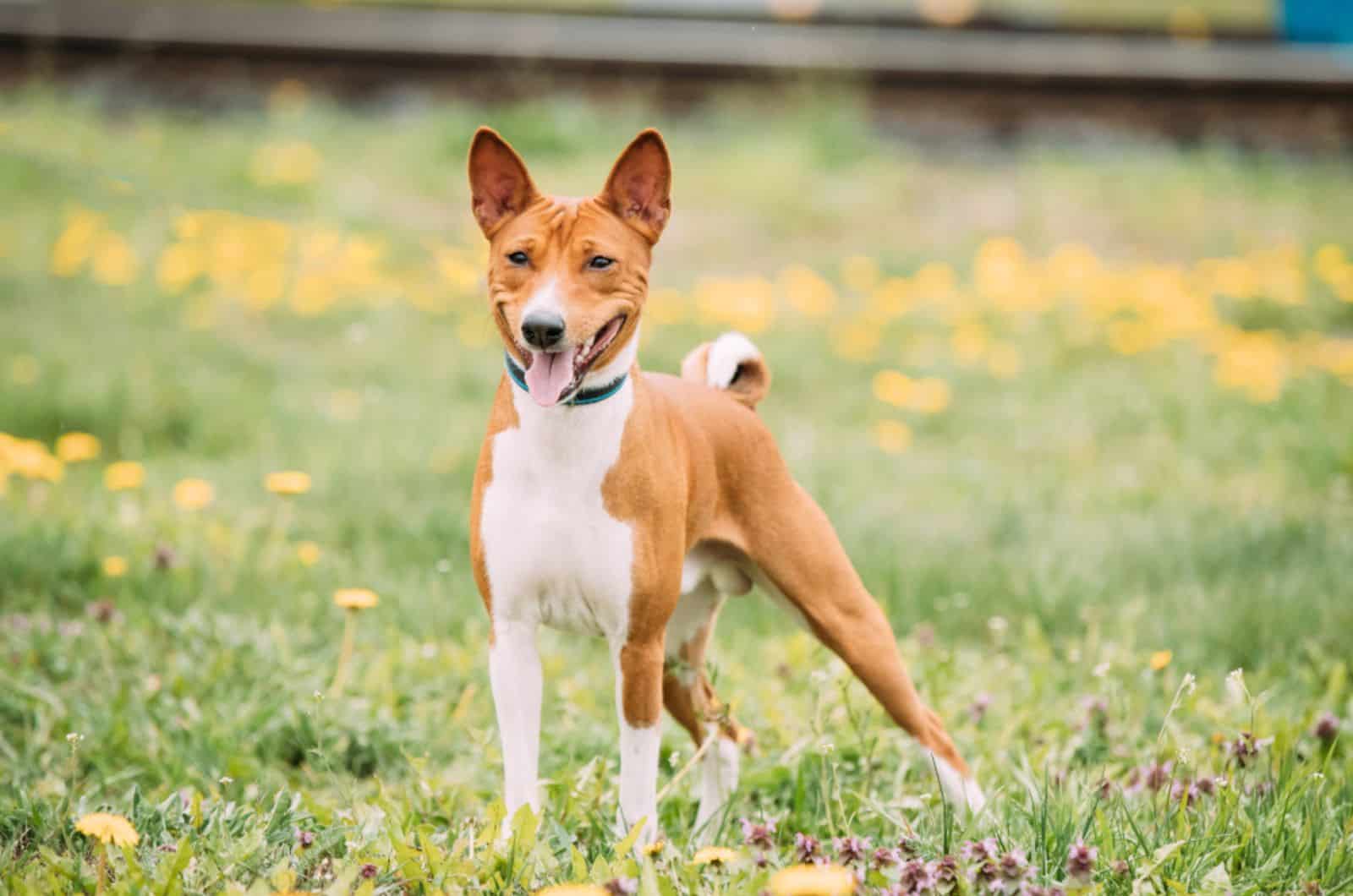Basenjis are called barkless dogs. They are agile and fast dogs, with an independent spirit.
We know about its unique looks and temperamental traits. But, what about the size?
They are sighthounds, bred to hunt fast prey day and night. So, does that mean they grow to be as big as English Greyhounds? Or, are they as small as Italian Greyhounds?
Well, that’s why we have a Basenji growth chart, the perfect “tool” to help us learn all about the Basenji’s development from day one to adulthood.
They are one of the smallest hounds, but this doesn’t mean they are petite.
Of course, you can’t expect a Basenji to grow into a giant Irish Wolfhound – that’s absurd. But, they won’t be as small as a Chihuahua…
They aren’t a mystery – we know how big the smallest hound is, and it is all written down in a chart.
This chart can be useful for all Basenji owners wondering if their Basenji puppies are developing at a normal rate.
You can find all important milestones in the Basenji’s size development – from the day they were born until they are fully grown and mature.
Also, there is a slight difference between a male and a female.
Don’t worry – it’s all in the chart, which is divided into a chart for female Basenjis and a chart for male Basenji.
Let’s see what we’ve got…
Basenji Growth Chart
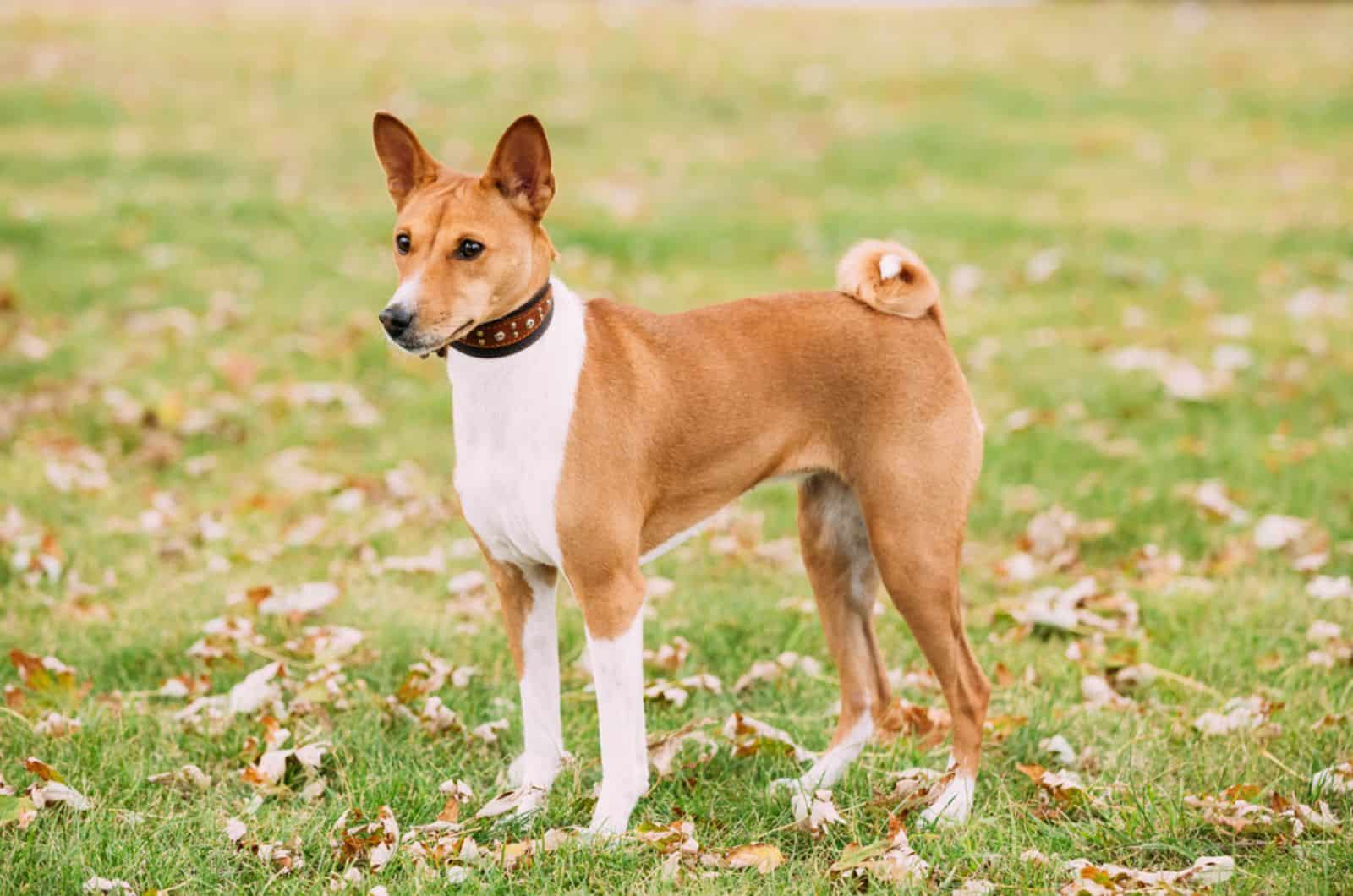
Charts are a useful way to easily follow the development of your dog. They show the average expected weight of a puppy in different life stages. All puppies are born small, but there are differences in size between Basenji puppies and big-dog puppies.
Also, even though they all look almost the same when they are newborn pups, there are slight size differences between female and male Basenji puppies.
In general, a male is slightly larger in weight and height than a female. But, this is not as obvious as in other, bigger dog breeds.
The difference is just a pound or two or an inch or two. But, it is worth mentioning since it can be more noticeable in some dogs. For example, a male dog can weigh 24 pounds and a female can weigh 20 pounds.
That is a difference that can be easily noticed.
So, because of it, we will show you separate male and female charts.
Basenji Growth Chart For A Male
[table id=708 /]
*A male Basenji dog can grow up to 17 inches (43 cm)
Basenji Growth Chart For A Female
[table id=709 /]
*A female Basenji can grow up to 16 inches (40 cm)
Basenji Growth Chart Through Different Life Stages
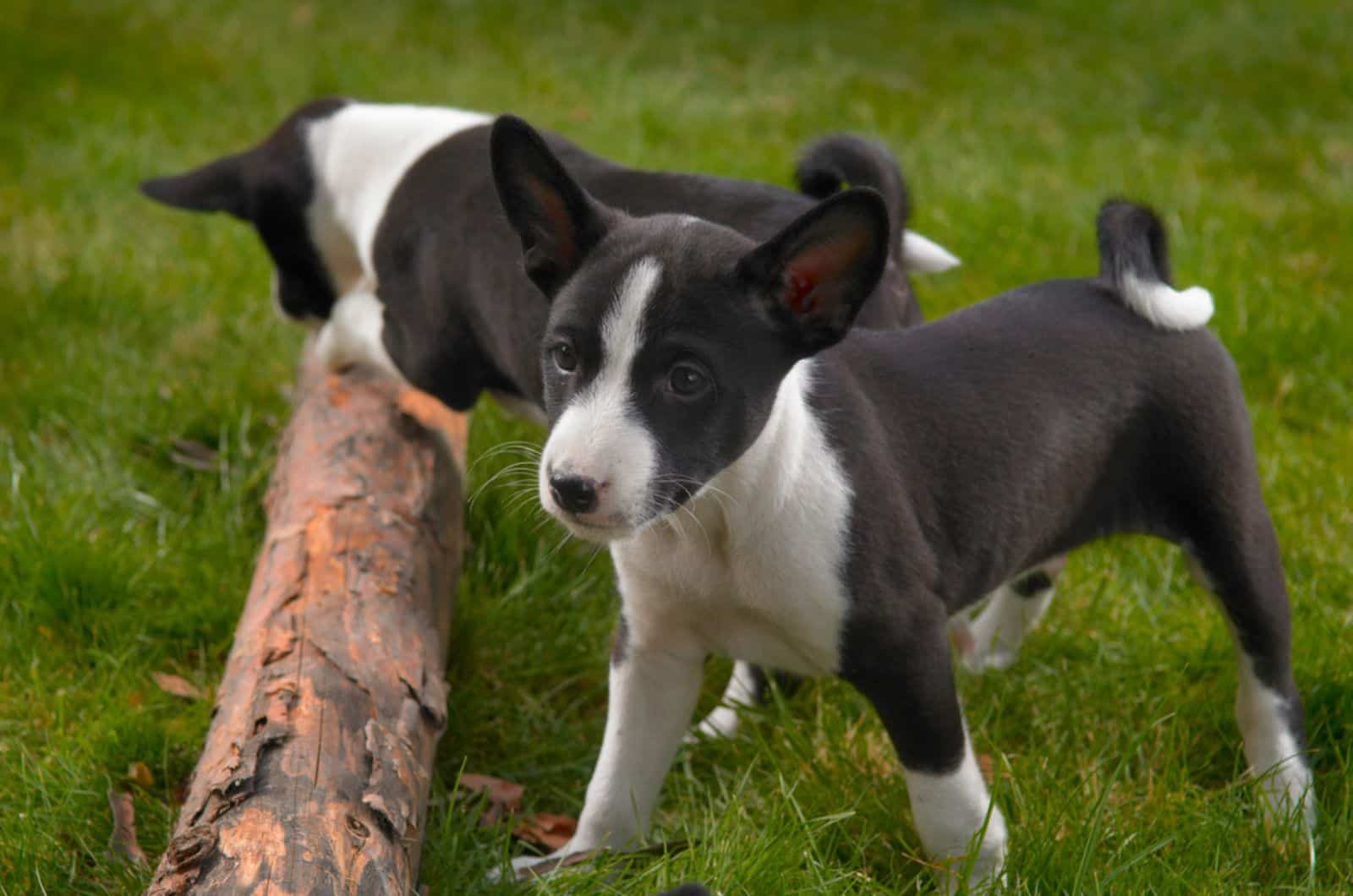
We can see from the charts above that there are weight differences between a Basenji female and male. In general, the weight of Basenji adult males should be around 24 pounds. Females are right behind them, with an average weight of around 22 pounds.
A dog goes through different stages of development. They start with just a couple of pounds, and they grow into adult dogs in twelve months.
Different stages have different types of development. The growth of a Basenji is more rapid during the first months of development than in the last couple of months. This is not only unique to Basenjis, but to other dogs as well.
You can use this chart to find out how big Basenjis get, and to determine if the weight of your Basenji is correct. When you look at the weight chart, you have to understand that these are average numbers.
There are always cases where a dog is much smaller or much bigger than the average. This doesn’t mean your dog is not normal. Many external and internal factors can influence your puppy’s growth, and consequently, its weight.
But, unlike the unpredictability of the size of the mixed puppy, a purebred puppy’s size is predictable and well-known as long as the dog’s parents are according to the American Kennel Club breed standards.
Birth To 3 Months
The average weight of newborn Basenji puppies is between 2 and 3 pounds. At this stage, you can see that some puppies are bigger than others, but there are still no distinctive differences in size.
The female puppies will usually be smaller, even at birth, but it doesn’t have to be the case with each Basenji puppy litter. On the first day of their puppy life, the weighings of each pup are approximately the same.
No matter their size at birth, the important thing is that they double their size by the end of the first week.
The puppies can do that because their mother’s milk is rich in proteins and other nutritious substances. The first milk a female dog produces is called colostrum, and it is also very rich in antibodies. This is important for the immune system of the puppies.
It is their first line of defense against viruses and bacteria.
If you think that some of the puppies are underweight or you think they are much smaller than the rest of the litter — you can call the vet to ask about supplemental puppy formulas.
There are ways to check if everything is alright with the puppy at your home. Check its belly, for example, or see if it reacts to touch. Remember, newborn dogs are deaf and blind.
You shouldn’t take a newborn puppy to the vet unless it is absolutely necessary. If it’s possible, it is better to have a house visit than to take such a small puppy outside.
Weaning Process
As mentioned, this is a period of rapid growth and changes in the Basenji’s size. It’s not just their size that changes, but their entire body. This is also a period of diet change.
Puppies go from only eating milk to eating solid food. It is a normal process, and it’s called the weaning process. This happens when the pups are two or three weeks old.
You can help your pups during this period by giving them puppy mush — kibble softened in water or milk. Also, you should leave food available for puppies to eat whenever they want. This is called free feeding, and it applies only to the weaning process.
3 To 4 Months
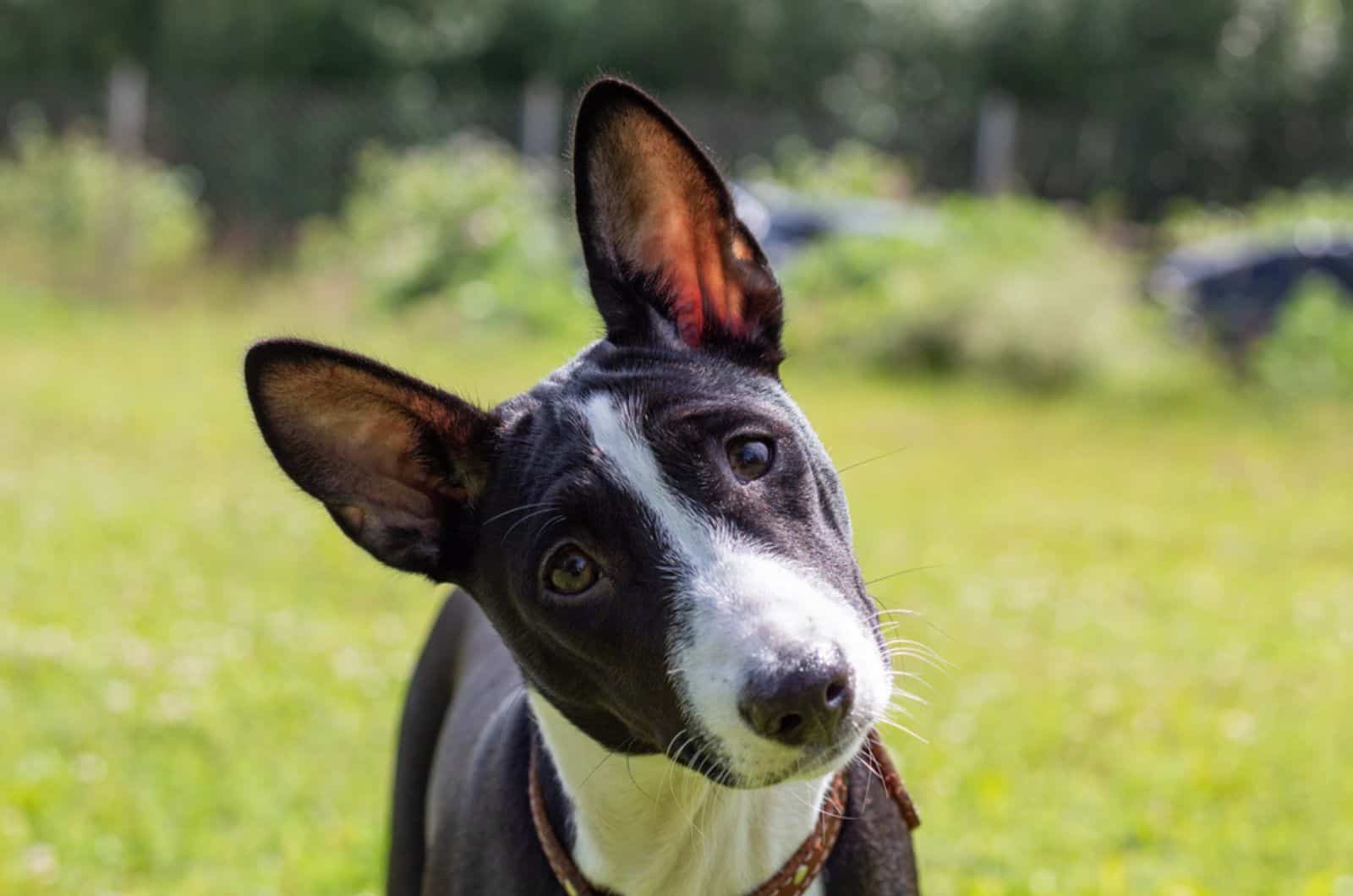
When the pups turn three months old, both male and female Basenji puppies should weigh three to four pounds. There are slight differences in size, but in general — all pups should weigh approximately the same.
As the third month goes by, and the pups enter the fourth month of age, we can see a more distinguishable size difference between male and female puppies.
According to the Basenji growth chart, by the end of the fourth month, male puppies should weigh from five to six pounds, and females, from four to five pounds.
By now, the puppies should be completely weaned, and they should start eating solid dog food. To maintain a healthy weight, you should continue feeding the puppies and their mom with high-quality dog food.
This means giving them food that is rich in proteins and low in carbohydrates. They should also have enough vitamins and minerals in their food as well as healthy fats to support the development of their nervous system.
This is also the perfect period to start the socialization process of your puppies. Their puppy brain is also developing rapidly, soaking up information all the time. Because of this, it is an excellent opportunity to teach them proper behavior.
If you plan on letting your puppies out in the yard, be sure to have a well-fenced yard. The Basenjis have a very high prey drive, and they will chase anything that moves. That’s why socialization is crucial in this period.
Teething Period
As they enter the third month, a process called teething starts. Just like humans, dogs also have milky teeth (or baby teeth that change into adult teeth over time). But first, the teeth have to erupt. The first set of teeth is called deciduous, milky, or baby teeth.
If we don’t teach the puppies what is alright to chew, we could have a big problem. Dogs are naturally curious, and they love to taste and smell things around them. But, when they have erupting teeth causing pain or discomfort — they’ll chew as well.
Puppies that are in this period can change their eating habits. They might avoid food, they can start eating less, or they could show other teething symptoms. It’s all because of the sensitivity of the gums surrounding the erupting tooth.
Although eating habits can be different, the change is not that big to cause serious changes in the Basenji growth chart. And, it is definitely a change that will pass, and the puppies will go back to normal eating habits.
If you want to help your dogs during this period, you can keep on making them puppy mush or you can give them some toys to chew on and help them with their gum irritation. Also, don’t be alarmed if the puppy starts to drool excessively.
This is also one of the symptoms of the teething process. You can use some home remedies for drooling or you can wait for the teething to pass.
5 To 6 Months
The puppies are slowly, but surely approaching their teenage phase. It is the start of the hormone chaos. As their bloodstream fills with sex hormones, their body continues to grow, and by the end of the fifth month, male puppies should weigh around 7 pounds.
Females have their own sex hormones, and they develop rapidly as well. But, they are still slightly smaller than the males — the females should weigh around 6 pounds by the time they reach their fifth month of age.
But, if you are a Basenji breeder or you happen to have a lot of Basenji puppies over the year, you will also notice that there are lots of females that are of the same size as males during this period. It is nothing alarming — it’s a normal thing that could happen in any dog breed.
When they reach the sixth month of age, male Basenji puppies should weigh ten to twelve pounds, and females, eight to eleven. If you are not planning on breeding the dogs, you should think about spaying or neutering.
Most veterinarians recommend spaying a female dog when she is six months old. But, each dog is an individual, and you should talk to your vet about when the best time is to spay your Basenji female dog.
The age when puppies reach sexual maturity depends a lot on the parent breed of dog. Bigger dog breeds tend to mature more slowly and reach sexual maturity later in life.
The Basenji is a small dog, and like other small dogs, it can reach its sexual maturity much sooner — even when it is five months old. There are signs that a dog needs to be neutered, and there are some signs for a female, too.
7 To 8 Months
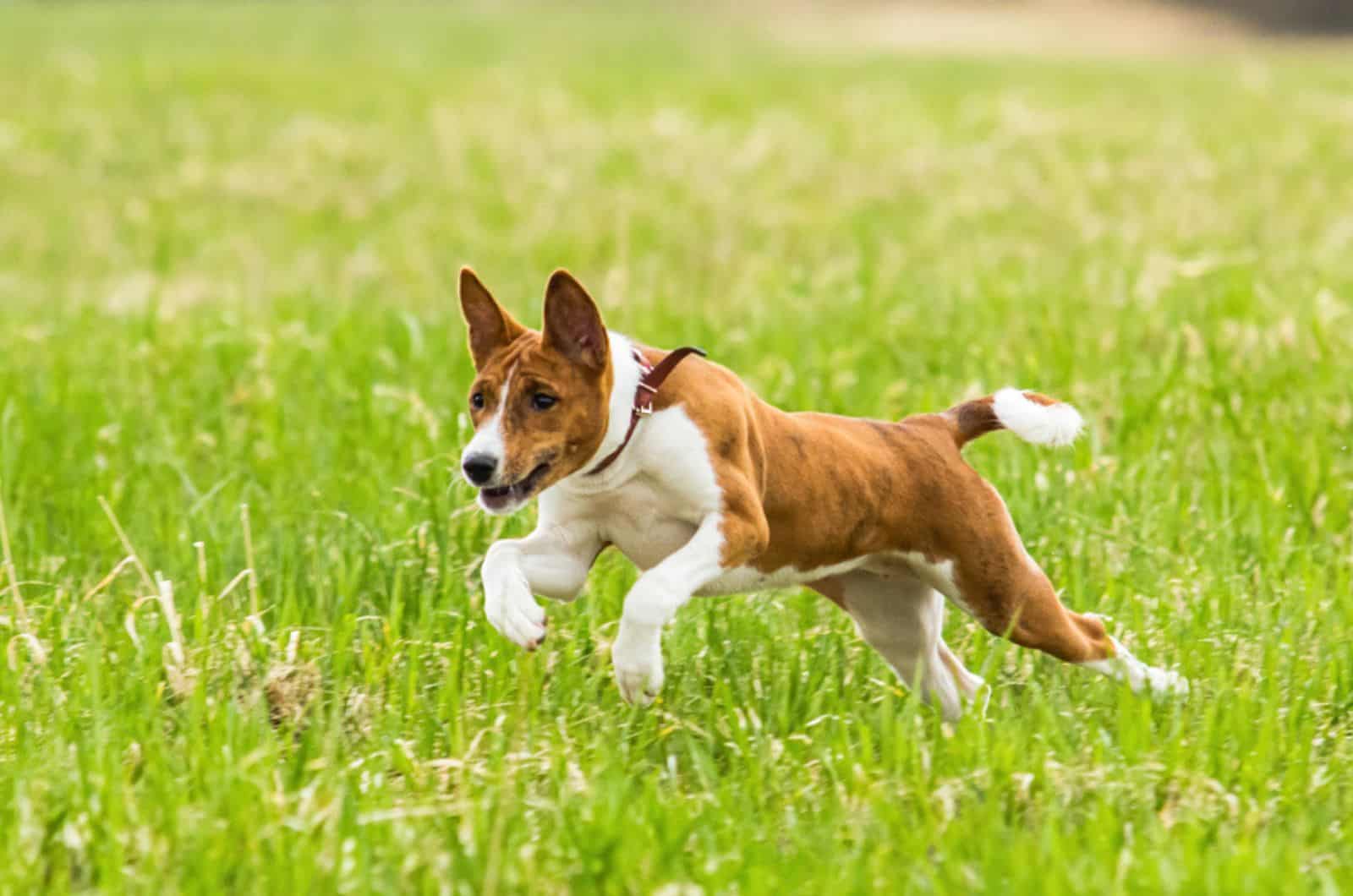
This is the period when most dog owners feel the so-called puppy blues. Having one teenage dog can be exhausting, but having four or five can be unbearable.
But, don’t worry — puppies get easier over time. They will calm down, become more obedient, and will learn basic commands and dos and don’ts. Of course, socialization is the key to a calm and obedient adult dog.
As for their weight during this period, the female pups should be up to 16 pounds by the end of the eighth month of age, and males should be up to 17 pounds.
Both males and females have more growing to do to reach adult size, according to the Basenji growth chart. The pups should be fed two times a day – one meal in the morning and the other one in the evening.
This way, you are helping them maintain a healthy dog weight and avoiding obesity. This is a health issue of adult dogs, but it can be present in 8-month-old puppies as well. Also, remember that your dogs need fresh water available at all times.
9 To 10 Months
When a male Basenji dog reaches the ninth month of age, it should weigh from 17 to 19 pounds. Females are, as you’ve guessed it, different — they should weigh from 16 to 18 pounds.
The dogs have almost reached adult weight. But, they still have some pounds to add, and they still need the best dog food you can give them — lots of proteins, vitamins, healthy fats, and minerals.
If you want to give your dogs some vegetables or fruits as a source of vitamins and minerals, you can give them some Brussels sprouts, bananas, broccoli, etc. Just remember to pay attention to their calorie intake.
As we already mentioned, puppies can get overweight. An obese dog is not a healthy dog, and such a condition can lead to a shorter lifespan because of the health problems connected to obesity.
Even though Basenjis have a long life expectancy, around 16 years, they are still at risk of premature death if we don’t take care of their health, and that means taking care of their weight as well.
11 To 12 Months
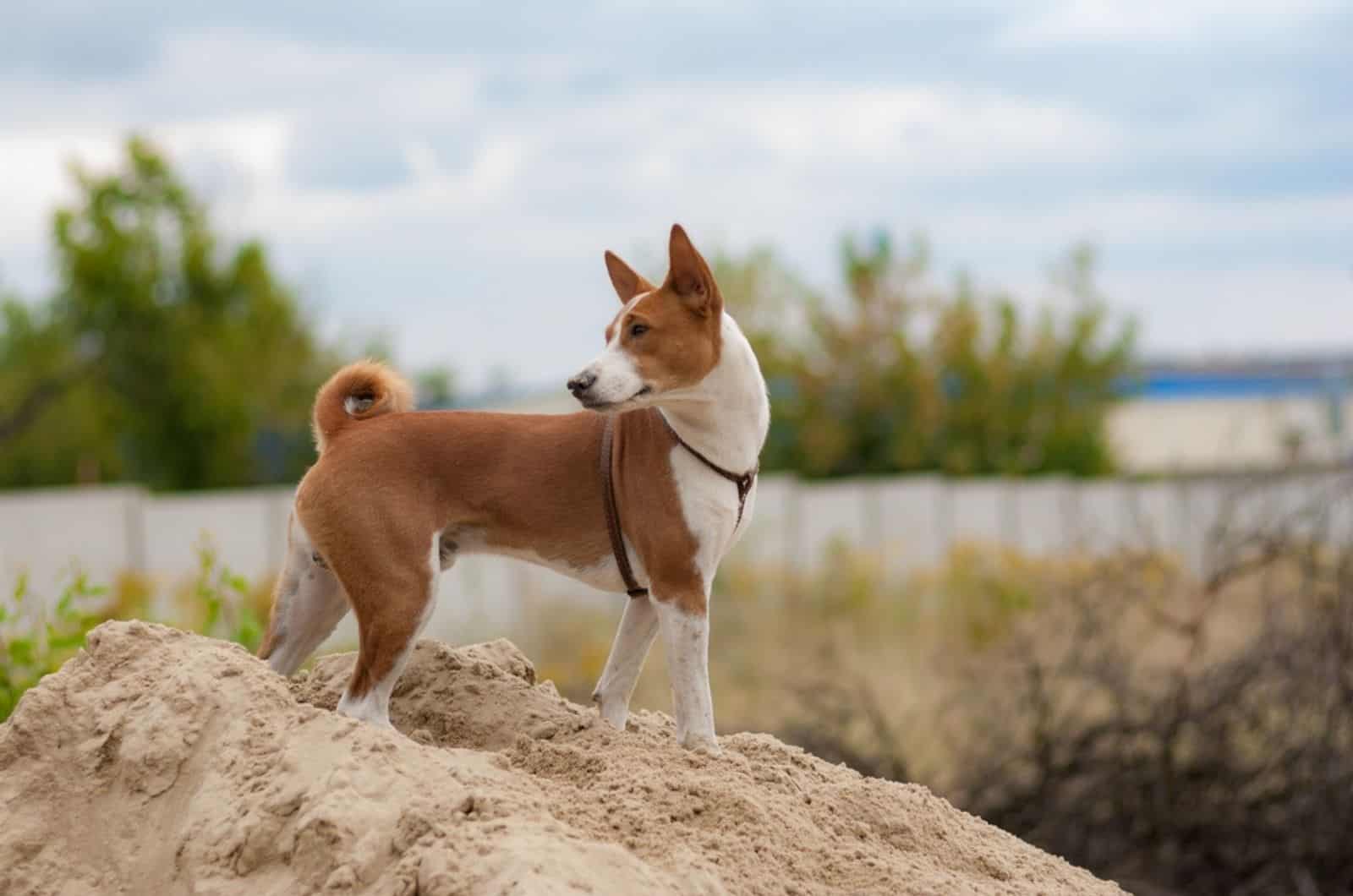
A dog that has entered its 11th month of age is almost an adult dog. The male Basenji growth chart tells us that the average size during this period is from 21 to 23 pounds. The average weight for females is from 19 to 20 pounds.
As it reaches its adult years, the puppies’ weight doesn’t change drastically anymore. It’s just a few pounds up… nothing too much.
An eleven-month-old Basenji puppy is still just a puppy, which means they still need proper puppy food. By now, you should have developed a good puppy schedule to continue using throughout the dog’s adulthood.
Transitioning to adult dog food is appropriate after they turn one year of age. Up until then, puppy kibble is the perfect option — it has all the vitamins, minerals, and, of course, proteins.
Adult Years
If we take a look at the Basenji growth chart for a female dog, we can see that an adult female Basenji should weigh from 21 to 23 pounds. An adult male Basenji is bigger — its weight should be from 23 to 25 pounds.
This is an active dog breed that needs lots of exercise and mental stimulation as well. You will need to take your Basenji for a long walk or play with it long enough to satisfy its activity needs.
As adult dogs, they will need never-ending care — from vet checks and vaccinations to cuddles and playtime.
If, by looking at the Basenji growth chart, you think your dog is underweight or overweight, there is an easy way to be sure if this is really the truth. You can use the Body Condition Score. It is easy to use, and you can do it at home.
What Can Influence Basenji Growth?
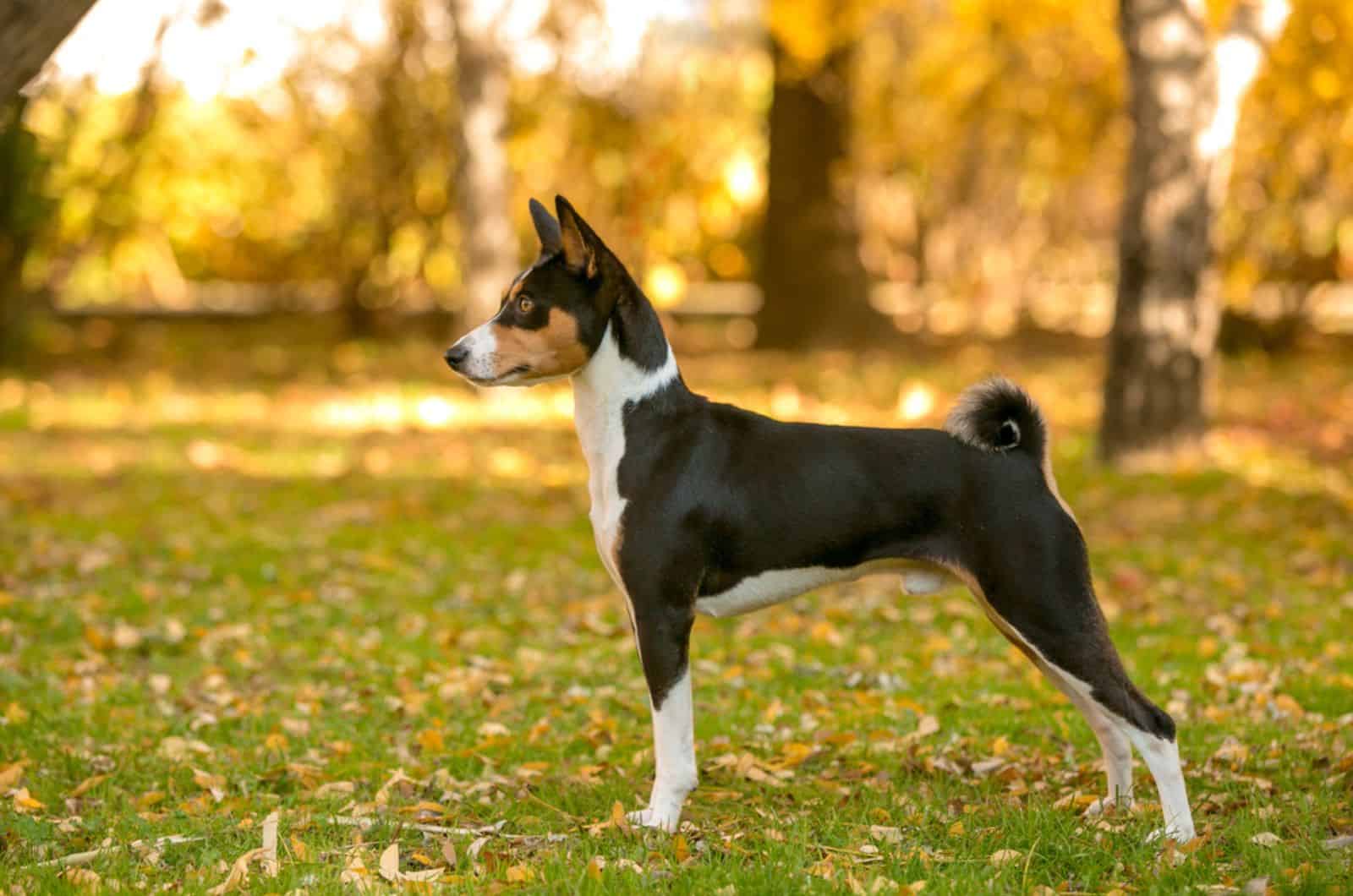
We have seen the Basenji growth chart, which shows the average size of a puppy depending on the puppy’s age.
These numbers can change according to external and internal factors. The internal factors are genes, hormones, and hereditary diseases. The last one can be prevented by doing a DNA test on the dog’s parents.
Dogs that have hereditary diseases shouldn’t be used in breeding. This is a rule that all responsible breeders follow.
External influences or factors are bacterial and viral diseases, injuries, food, and exercise. Generally speaking, viruses and bacterias cause a loss of weight, while other mentioned external factors can do both — cause weight gain or weight loss.
The Conclusion
The Basenji is a small dog. We’ve seen in the Basenji growth chart that an adult male weighs up to 25 pounds, and an adult female, up to 23 pounds.
These are average numbers that can be different from dog to dog. We have also seen that there are many factors that can change these numbers.
But, the bottom line is that we keep our dogs healthy by giving them high-quality food, giving them the appropriate amount of exercise, taking them for an appropriate number of daily walks, and taking them to regular vet checkups.
You can use this chart as an insight into how much a normal male or female Basenji puppy or adult dog weighs.
Once you know the average and normal size, you can easily keep an eye on your dog and notice any change in its weight. If the changes in your dog’s weight are rapid — take it to the vet.
It doesn’t necessarily have to be something serious, but it is always better to check and be sure than to guess when it comes to our furry friends.
